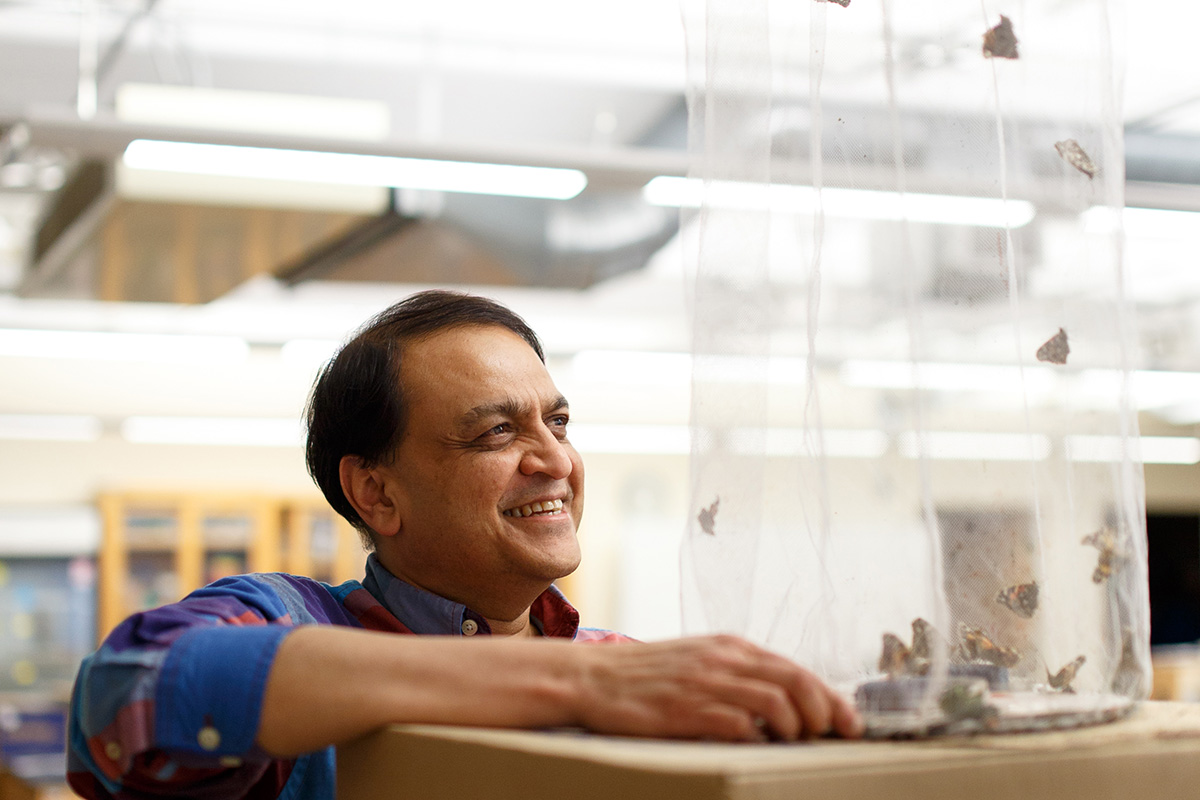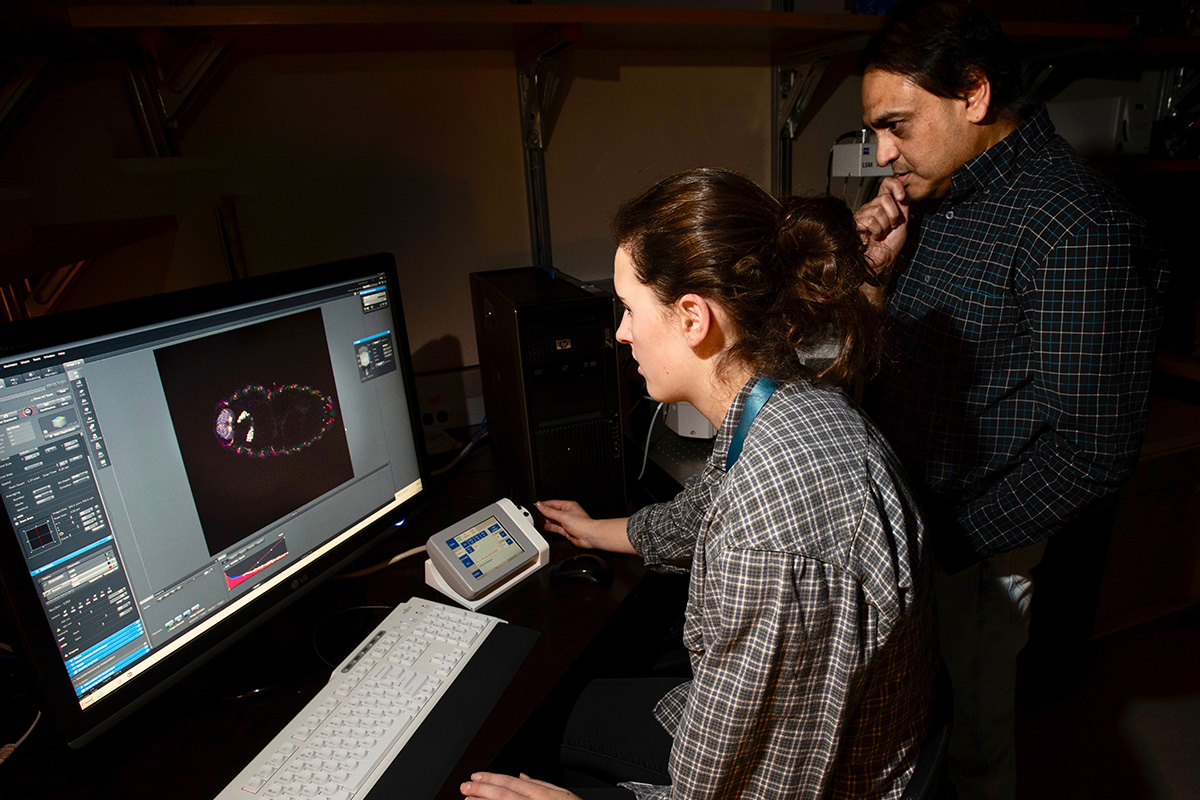Catching Up With MBL Director Nipam Patel

Last September, the MBL welcomed a new Director, Nipam Patel, who was a longtime MBL summer course faculty member while he was a professor at the University of California, Berkeley, and at the University of Chicago. In this edited interview, Dr. Patel reflects on the MBL’s unique strengths and possibilities for its future, and shares his passion for science.
Why did you decide to become a scientist?
I was really interested in science from the time I was in elementary school. I was just fascinated with nature and trying experiments. My parents were very encouraging and would buy me chemistry kits and science books, and my friends and I would build things like rockets, which was dangerous but fun. I grew up in the desert in El Paso, Texas, which was a great place to spend a lot of time outdoors. I started collecting things - rocks and all sorts of random things, but what stuck was my butterfly collecting. I started that when I was 8 years old and my collection now has thousands of specimens.
I also was lucky to have exceptional teachers, especially in high school. They taught very advanced courses, so for example I got to take a course in embryology. It was taught out of a little German textbook and we did experiments with chicken eggs from local farms. And then I had the opportunity to do research at University of Texas, Austin, through a National Science Foundation-sponsored summer program for high-school students. I worked in a lab, and I even got my first first-author paper from work I did on blood cell development in chicken embryos. That got me totally hooked on doing research at a pretty young age. For a while I was considering the MD/PhD route, but the more I got into basic research the more I realized that was exactly what I wanted to do.
When did you first come to the MBL?
I was invited to lecture in the Molecular Evolution course in 2000. The next year, Scott Fraser and Marianne Bronner invited me to teach in the Embryology course, which was great fun. And then I was hooked. I’ve been coming back to the Embryology course ever since, including five years when Lee Niswander and I were course directors.
What were your first impressions of the MBL?
I'd never been to Cape Cod, and so I was struck by how beautiful it was. I remember how active and fun the MBL was. When I got to the Embryology course, all the famous people in the field were here teaching it, so it was kind of overwhelming but also an amazing opportunity. These might be people I would see at scientific meetings, but in the course I was interacting with them in a way that would not occur at a meeting or seminar visit, trying to design and carry out experiments together with them.
What do you see as the core attributes of the way MBL approaches education?
One great thing about the Advanced Research Training courses is the fearlessness of the students. They are really engaged and willing to take on challenges. The faculty always joke that we give them projects that we would never give to our own graduate students, because the projects sometimes seem so crazy. And then the students dream up even crazier things to try! We always do our best to help them, to figure out what they need for the experiment. And the students really latch on and work incredibly hard. Most of the time, things fail just as you’d expect, but the students learn a lot from that. And then almost always, a group of students will get something that’s amazing, that you didn't expect would work. It's really remarkable how many times they get really cool results.
Another amazing thing about the MBL courses is everyone works together. There's no rigid class structure. The students are being helped by Nobel Prize winners who are sitting side by side with them at the microscope, doing experiments. That breakdown in barriers, the willingness to just freely help each other at all hours of the day and night, is one of the incredibly special things about the MBL.
For 18 years, you came to MBL just in the summer. Now that you are here year-round, has anything about MBL surprised you?
Just getting familiar with the MBL’s resident research program has been new to me. This is one of the issues the MBL faces – there needs to be a better interface between the summer programs and the resident research programs. There are so many opportunities there for greater interaction. For instance, when I look at some of the amazing things that the imaging people here can do with polarized light, I think, "Well, why weren't we doing that in the Embryology course?" The Physiology course has long taken advantage of that expertise, but other courses have not. So while we don’t want to dictate to the course directors what they do – they are eminent scientists who have a vision for their course – if they had a better idea of what was going on in the resident program, I’m sure they would see ways to take greater advantage of it.
How would you compare the culture of the University of Chicago with that of MBL?
Like the MBL, the University of Chicago is a place that's intellectually brave, where people and professors are encouraged to think big and to try exciting things. That's also true of University of Chicago students: They are given a lot of freedom to try things they are interested in doing. In terms of differences, obviously UChicago has a long history of excellence in fields other than sciences – in humanities and economics and business and law. And the other big difference is the faculty at Chicago teach throughout the year, whereas right now teaching at the MBL is primarily focused on the summer.
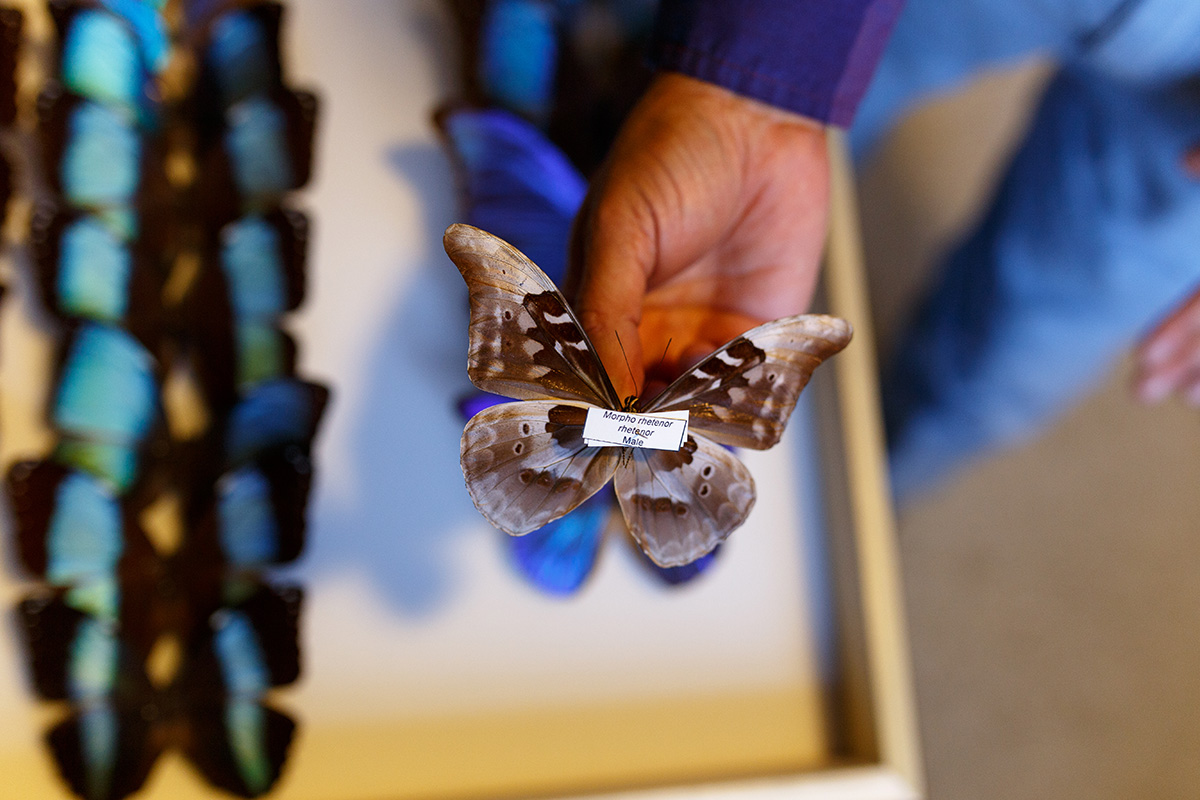 Nipam Patel displays a Morpho butterfly from his collection in Lillie Laboratory. This is the underside; the reverse is brilliant blue. Credit: Dee Sullivan.
Nipam Patel displays a Morpho butterfly from his collection in Lillie Laboratory. This is the underside; the reverse is brilliant blue. Credit: Dee Sullivan.But one potential area for MBL to head is having an expanded educational role on a year-round basis. That includes teaching undergraduates here from the University of Chicago as well as from other institutions, along with graduate students, post docs, high school students, the whole gamut. That makes sense given that we have incredible facilities and equipment for teaching. I'd like this to be part of the future of the MBL, but it does depend on having people here who really want to teach.
Do you also foresee expanding visiting research at the MBL Whitman Center?
Yes. The Whitman Center, between September and May, is never going to be as big as it is in the summer, because faculty at universities don’t have as much free time the rest of the year. But I think we can get it to be much more year-round. There are three things that make the Whitman Center work so well in the summer: the other people, the equipment, and the research organisms that are available. We don't have those three things at nearly the same level during the rest of the year, but we can change that. So for example, a goal of the MBL’s imaging program is to have more advanced microscopy and other equipment here permanently, not just built here in summer and then taken away. And typically many embryos and organisms, such as cephalopods, are available only a few months a year. But as we develop new animal model systems, for example cephalopods, and we are breeding and raising them continuously, investigators can get them anytime they want. So if the equipment and the organisms are here year-round, then hopefully, we can attract the people to be here.
MBL researchers are working on all kinds of questions, at scales ranging from molecular to planetary. Do you see that diversity as an advantage or a drawback?
It's a plus and a minus. One of the things that makes science work at a university or research institute like the MBL is the scientists get to decide what they work on, the questions that fascinate them, and that's what drives them. That’s different than in industry, where you're basically told what to work on. And that’s why the MBL works on a pretty diverse set of things. The great thing is you have expertise and strengths in all sorts of areas of biology. That's especially nice in marine biology, because to really understand that environment, you need ecosystems-level work, you need molecular work, you need genomic work. The downside is that it’s harder to coordinate efforts. It's harder to get equipment that really helps everyone, for example. So it’s a plus and a minus to any institution.
How do you envision the MBL 10 years from now?
That's what we're working on now – developing that plan. One part is expanding the resident scientists’ program in a coherent, meaningful way, thinking of MBL’s present strengths and the directions in which it wants to go. We're not going to get there overnight. But our hope is that in 10 years we'll be back to about 35 resident faculty.
Another part is to have increased opportunities for teaching. We had a very successful first run with our course for high-school students last fall, which was great fun. I taught three afternoons and I really enjoyed it. We hope to add undergraduate courses, both on the model of the MBL’s Semester in Environmental Science, where the students are from multiple universities, and courses for University of Chicago students. And we can’t accept all the graduate students and post-docs who apply to the summer courses, so there may be opportunities for them to take different courses in similar topics in the non-summer months. Some of our resident faculty could launch courses in, say, invertebrate zoology, developmental and regenerative biology, and genome analysis in the off months. Again, beefing up the imaging program and the availability of animals year-round will help make those courses really possible. Another important goal is to train graduate students from the University of Chicago here. Hopefully by the summer of 2020 we'll have more UChicago graduate students rotating in the MBL labs.
—###—
The Marine Biological Laboratory (MBL) is dedicated to scientific discovery – exploring fundamental biology, understanding marine biodiversity and the environment, and informing the human condition through research and education. Founded in Woods Hole, Massachusetts in 1888, the MBL is a private, nonprofit institution and an affiliate of the University of Chicago.
Adventures in Evo-Devo
Nipam Patel’s lab is in the process of moving to the MBL. Below, he discusses highlights of his lab’s research. Half of my lab works on Parhyale hawaiensis [or beach hopper, a small crustacean], a research system we’ve developed to study many aspects of development and evolution, including how body plans evolve. We've been developing this model since I was at University of Chicago [1995-2003] and a graduate student in my lab isolated the animals from the filtration system at Shedd Aquarium. Parhyale is a very nice example of how you go from a system that was almost never worked on to the sort of model we have now, where we have lots of experimental approaches that work very well, including genome editing. It took quite a long time to do, but given the recent advances in so many techniques, such as genome sequencing and gene editing with CRISPR-Cas9, now we can envision recapitulating that same level of progress in much less time with an increasing diversity of new research organisms.
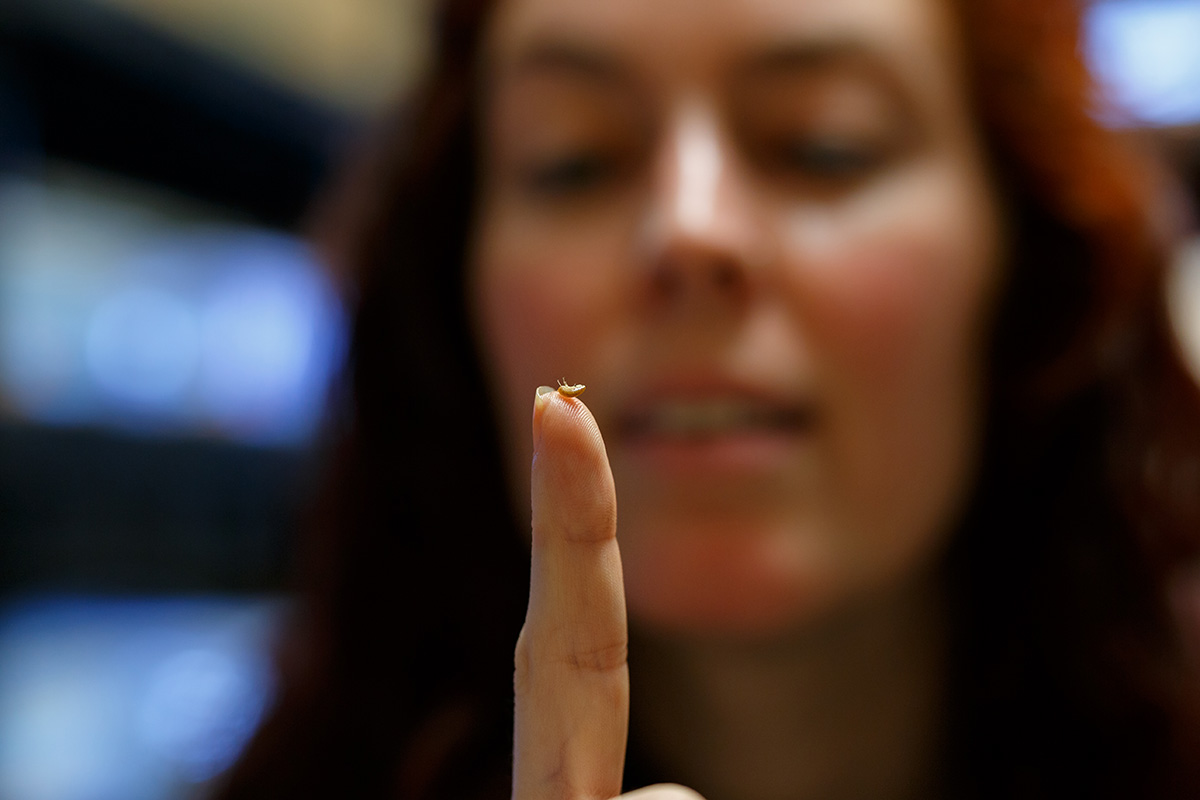 Patel lab Research Associate Heather Bruce balances the tiny crustacean Parhyale on her fingertip. Credit: Dee Sullivan
Patel lab Research Associate Heather Bruce balances the tiny crustacean Parhyale on her fingertip. Credit: Dee SullivanAnd Parhyale has worked well because we’ve had interesting questions to ask. Parhyale has a very different mechanism for setting up its body segments than Drosophila does, and it has a rich diversity of limb morphologies that we were using to understand how the body plan is put together. One focus has been the role of Hox genes in the control of limb identity, and that work has gone really well. We published a paper where we used CRISPR-Cas9 to knock out six of the nine Hox genes at once, which gave us a relatively comprehensive initial understanding of how limb specification works, which we have now followed up on with more detailed analyses, including the production of double and triple mutants. Furthermore, our results led to interesting evolutionary insights, because knowing how these genes functioned in Parhyale painted a completely different picture of how these genes were involved in the evolution of the crustacean body plan than we would have had using just the data from insects. One of the things we're excited about at the MBL is now we can expand this research to other crustaceans. And finally, we discovered that Parhyale can regenerate its germline, so that’s something we are excited by and will keep studying.
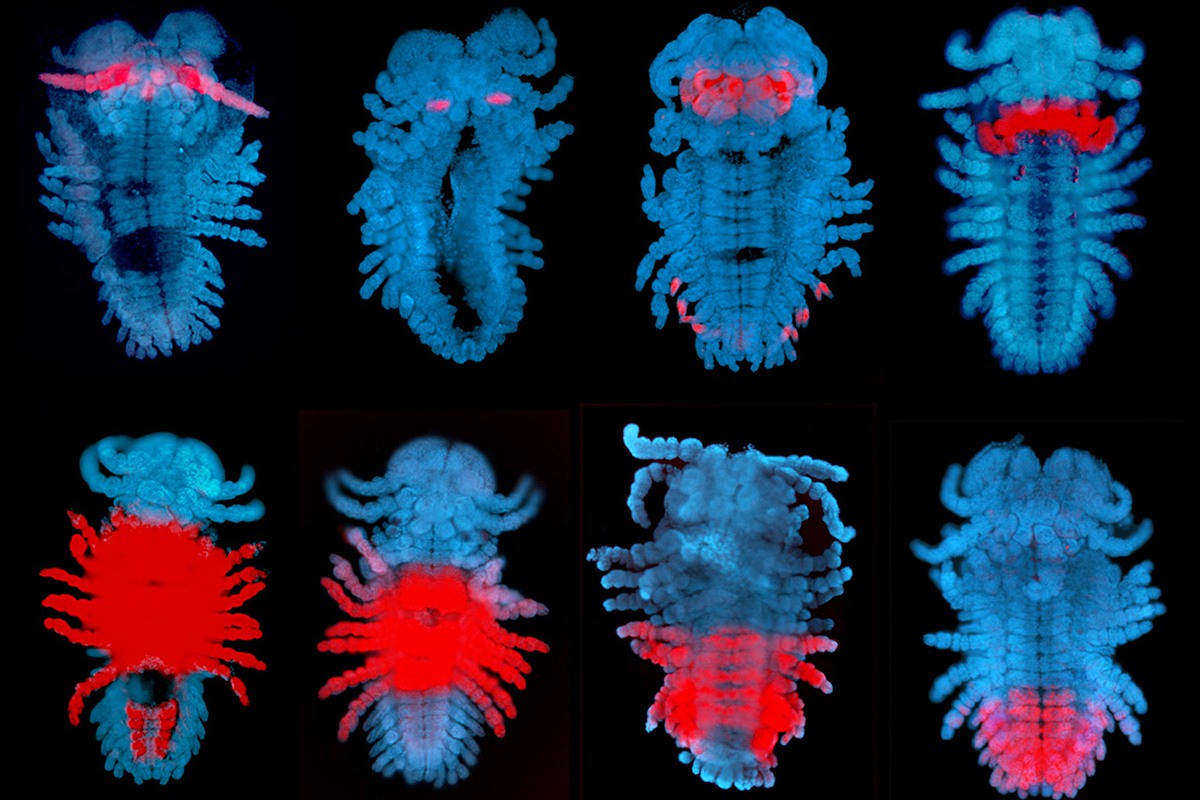 Embryos of the amphipod crustacean, Parhyale hawaiensis, at about halfway through embryonic development. The red staining shows the expression pattern of different Hox (homeotic) genes along the anterior-posterior axis. Credit: Julia Serano, Danielle Liubicich and Nipam Patel
Embryos of the amphipod crustacean, Parhyale hawaiensis, at about halfway through embryonic development. The red staining shows the expression pattern of different Hox (homeotic) genes along the anterior-posterior axis. Credit: Julia Serano, Danielle Liubicich and Nipam PatelThe other part of my lab works with butterflies. We are interested in the biology of structural color and transparency. The physics of how these phenomena work is understood, but we are trying to decipher the cellular and genetic basis of how they are built by the wing scale cells. Aaron Pomerantz and Yuriko Kishi, for instance, are studying moths that create transparent windows in their wings, and trying to understand how they get an area of the wing with no scales. And Rachel Thayer has made great strides in taking a genetic approach to understanding structural color -- the blues and greens in butterfly wings that are created by nanostructures that interact with light.
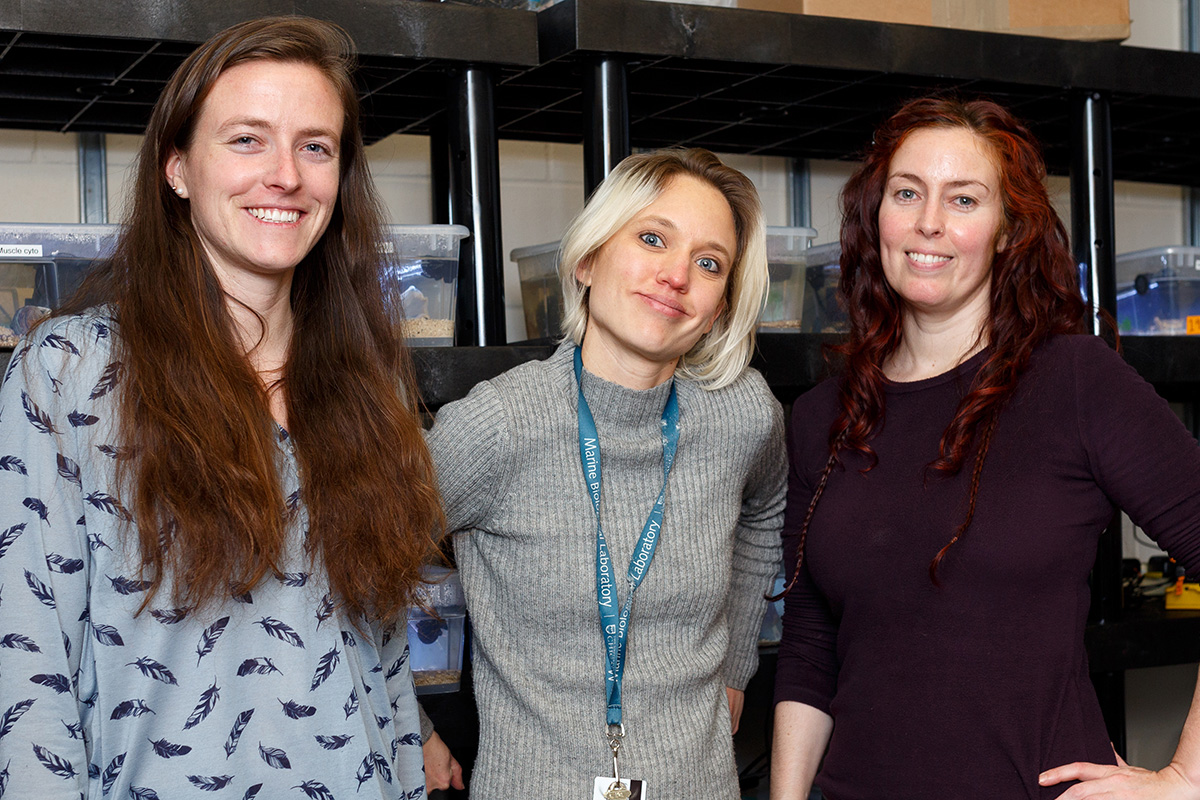 Members of the Patel lab at MBL with Parhyale tanks in Loeb Laboratory. From left are graduate student Jenny McCarthy (studying crustacean development), Senior Lab Manager Erin Jarvis (Hox gene research in Parhyale), and Research Associate Heather Bruce (evolution of insect wings). Not pictured: graduate students Kyle DeMarr (evolutionary origin of insect wing scales) and Aaron Pomerantz (transparency in butterflies). Credit: Dee Sullivan
Members of the Patel lab at MBL with Parhyale tanks in Loeb Laboratory. From left are graduate student Jenny McCarthy (studying crustacean development), Senior Lab Manager Erin Jarvis (Hox gene research in Parhyale), and Research Associate Heather Bruce (evolution of insect wings). Not pictured: graduate students Kyle DeMarr (evolutionary origin of insect wing scales) and Aaron Pomerantz (transparency in butterflies). Credit: Dee SullivanWe have ongoing collaborations with other scientists to understand some of these more elaborate wing nanostructures. For instance, there's a little green hairstreak butterfly that lives on the MBL campus outside of Homestead, and in its scales it has this very, very cool shape called a gyroid, which was a theoretical mathematical shape in the 1970s but it exists in real life in their scales, to create green color. There's a lot of debate as to how they build that complex nanostructure, and with several collaborators we are working on an interesting approach (using hyperspectral imaging of developing wings) to uncover that mechanism. That’s one of the exciting things about being at the MBL: Taking advantage of the imaging systems here to push our ability to see these structures being built.
